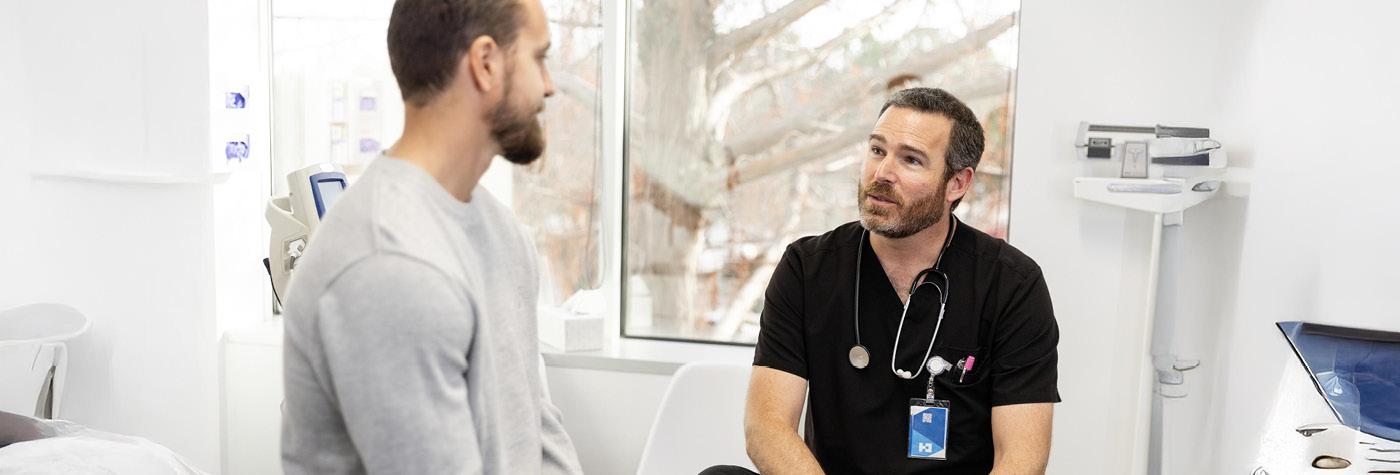If you or someone around you is experiencing signs of a heart attack, such as chest pain, shortness of breath, nausea, or discomfort in the arms, neck, jaw or back, call 911 immediately. Do not wait or try to drive yourself to the hospital. Every second counts, and emergency responders can begin life-saving treatment on the way to the hospital.
Unlike a STEMI heart attack, which is the result of a prolonged and complete blockage of a coronary artery, an NSTEMI is usually linked with either:
- Blood clots that block blood flow to the heart muscle
- Narrowing of the coronary artery
During an NSTEMI, there is usually no complete blockage in the coronary artery, so an ECG doesn’t show a specific electrical change. As a result, an NSTEMI can be a bit trickier to diagnose. Fortunately, the experts at the UK Gill Heart & Vascular Institute use additional technology to determine not only if you’re having a heart attack, but what type of heart attack it is.
Because a heart attack is a medical emergency, diagnosis will typically begin in an ambulance or helicopter on the way to the hospital. If you arrive in a car, your diagnosis will begin in the emergency department (ED). Your medical team will:
- Ask about your medical history and current medical conditions
- Examine your body, including your abdomen, eyes and ears, feet and ankles, neck, nose and mouth, and skin
- Listen to your heart and lungs with a stethoscope
- Check your blood pressure, heart rate and oxygen levels
If you are unconscious and unable to speak, your medical team will get as much information as possible from someone who came to the hospital with you.
If you’re having heart attack symptoms and arrive at UK by ambulance or helicopter, you may be taken straight to the cardiac catheterization lab for tests and treatment. If you arrive by car, you may first be evaluated in the emergency department before going to the cardiac catheterization lab.
A combination of other tests may also be used to diagnose an NSTEMI.
Blood tests, a common part of a medical exam, are tests that help doctors diagnose medical conditions. Blood tests can be used to check your overall health, and they can alert your doctor to changes occurring within your body.
During most blood tests, a healthcare provider inserts a needle into your arm at your elbow. The blood flows through the needle and into a tube, which is sealed and evaluated in a lab.
A blood test usually takes less than 15 minutes.
Troponin levels will be checked as part of your blood test. Troponin, a protein, is released into the bloodstream when the heart muscle is damaged.
An electrocardiogram is a noninvasive test that records your heart’s electrical activity.
During an electrocardiogram, temporary electrodes will be placed on the chest to monitor and record electrical signals. A computer then translates those signals into a wave pattern to be interpreted by a medical provider.
An electrocardiogram is a simple test that can be performed within minutes in an inpatient or outpatient setting. Other forms of ECG track the heart’s rhythms for longer periods of time. These include an event monitor, which is worn for a week or longer, and a Holter monitor, which is worn for up to 48 hours.
An echocardiogram (echo) uses ultrasound technology, or sound waves, to capture an image of your heart’s structure.
During the echocardiogram, your technologist will place a wand on the skin of your chest above your heart. Sound waves from the wand bounce off your heart, creating an image of your heart’s chambers and valves.
An echocardiogram is an outpatient test that takes less than an hour. You can return home as soon as the test is completed.
Coronary angiography, also called a coronary angiogram, is a test that evaluates your coronary arteries to determine if a narrowing or blockage is present.
A coronary angiogram is performed in the cardiac catheterization lab. You will receive sedation to help you relax. Depending on your health and the reason for your angiogram, you may be awake or you may receive general anesthesia so you’re completely asleep.
Your provider makes a small incision in your groin or wrist. A catheter is then inserted into the incision. This flexible tube is guided to the heart, and then a special dye is released from the tube. The contrast dye spreads through your heart and blood vessels. X-ray pictures then highlight blocked arteries causing your symptoms.
If you have a blockage, your doctor may choose to treat it right away. This may be done by inflating a balloon on the end of the catheter to expand the artery and remove the blockage. During this procedure, known as angioplasty, a mesh tube called a stent is often placed to help the artery stay open.
Depending on your condition, you might be able to go home the same day as your coronary angiogram, or you might need to stay in the hospital longer.
An exercise stress test shows how well your heart functions during physical activity. The test shows whether your level of exertion – or effort – reduces blood flow to the heart. During the test, you walk on a treadmill or ride a stationary bicycle while connected to heart monitoring equipment. You can resume regular activities as soon as this test is completed.








